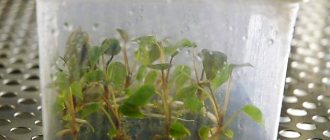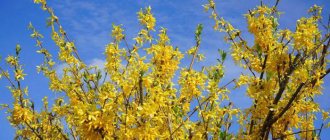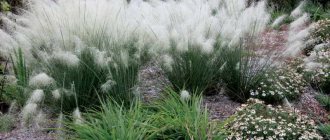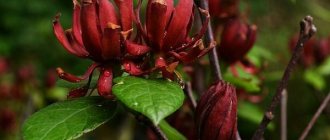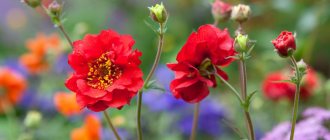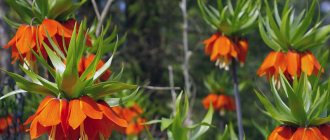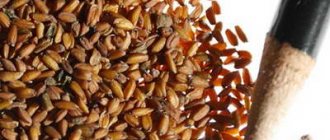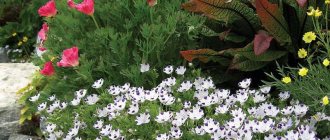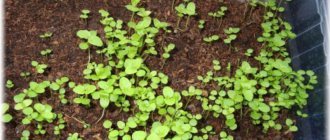Rhododendron planting and care in the Moscow region
To grow a beautiful and amazing plant called rhododendron at your summer cottage in the Moscow region, you need to know what subspecies of this tree exist and how to properly care for them.
Studying the origin of the exotic shrub and its natural habitat will help in this matter. Rhododendron is a magnificent plant in its decorativeness and diversity of species. Many gardeners are sure that due to its exotic origin it is very difficult to grow. In fact, if you follow fairly simple and understandable rules, you can become the owner of a handsome man even in areas with a rather harsh climate, for example, in central Russia, namely in the Moscow region.
Origin, natural habitat
Rhododendrons is the name of a genus that includes many species of deciduous, semi-evergreen and evergreen shrubs and trees.
To create the most favorable environment for development, it is worth remembering their habitat. The geography of distribution is quite wide. These amazing shrubs prefer places with high humidity - the coasts of seas, oceans, and large rivers. You can meet them in semi-shaded areas or on the northern slopes of the mountains. The soil in the growing areas is acidic, rich in nutrients and well permeable to moisture.
Varieties for central Russia
For planting in the Moscow region, you need to choose only frost-resistant varieties. Here are some of them.
- Rhododendron, then r. Ledebura;
- R. Katevbinsky and its hybrids;
- R. Smirnova and hybrids;
- R. Short-fruited;
- R. Largest;
- R. Golden;
- R. Canadian;
- R. Schlippenbach;
- R. Vazeya;
- R. Pukhansky;
- R. Adhesive;
- R. Pink.
Varieties for central Russia. Rhododendron pink
- And:
- R. "Costerianum";
- R. Japanese;
- R. Kamchatka;
- R. yellow;
- R. alpine (dwarf).
Rules and landing place
The most destructive natural factors for rhododendrons are wind and excess sun. Therefore, for planting, choose a protected place, on the north or north-east side of the house or fence, which will be shaded from the scorching rays of the sun. Exotics suffer not only from summer, but also from early spring sunlight.
Rhododendron buds, formed in August, often burn in the spring sun, which warms up enough already at the end of February. As a result, the bush blooms only from the north side and where it was covered with snow.
To prevent this from happening, rhododendron needs care. In early spring it is necessary to shade with shields on the southern and western sides. This is done using shading material, which is securely attached to stakes driven into the ground, 1.5 times higher than the rhododendron. Gaps must be left at the bottom and top for ventilation. For shading, available materials are used: lutrasil (density 60g per m2) or spunbond, burlap (stretched in a double layer).
Shading young rhododendron shoots
Rhododendron can be planted near other trees, remembering that trees with a shallow root system are bad neighbors for them. The battle for moisture and nutrients will end in the death of your pets. These include spruce, chestnut, linden, birch, and maple. But the proximity of pine, oak, and fruit trees is quite acceptable. Tree crowns should not overly shade low-growing shrubs.
As for the rhododendron root ball, it is compact and located close to the surface, so they tolerate replanting well, regardless of age.
The soil
Particular attention must be paid to the soil in which the bushes will be planted. As mentioned above, loose soil with an acidic environment and good removal of excess moisture is suitable for them. Drying out is also unacceptable. It is recommended to prepare the following earth mixture: sour, red-colored high-moor peat with pH = 4.5 - 5.5, loam and pine needles in proportions 2:3:1. All components are important and necessary, because peat provides the necessary acidity and nutrition, loam does not allow the soil to dry out excessively, and pine needles make the ball loose and breathable.
Problem with rhododendron leaves with low soil acidity
Soil acidity is one of the most important conditions for good shrub growth. Before planting rhododendron in the chosen location, substrate samples are taken to determine it. Then they are mixed, and one tbsp. The spoon is placed in a glass bowl. Distilled water is also added here (four times the amount). Mix everything thoroughly and leave for a couple of hours, sometimes shaking the mixture. Then indicator paper is moistened with it and the color of the paper is compared with the color of the scale. Thus, you can easily and simply determine the pH at home.
If you find out that the acidity of the soil is insufficient, it can be increased in various ways:
- For example, by adding sphagnum peat from high bogs (its pH is 3.6-4.0), heather soil.
- You can also add chemicals such as aluminum sulphate A12(SO4)3 (150 g per 1 m2 of soil), concentrated sulfuric acid (5 ml per 10 l of water). You just need to remember that you must add acid to water, and not vice versa. And this must be done very carefully. Rhododendrons are watered with the mixture several times during the growing season. This will help maintain the pH of the soil.
- Physiologically acidic fertilizers such as potassium sulfate (Sylvinite, Kainite, Kalimagnesia, Kalimag), superphosphate (Simple superphosphate, Double superphosphate, Phosphorite flour), ammonium sulfate are also a good way to maintain soil pH.
Where is the best place to plant rhododendron?
To drain excess moisture, it is better to plant rhododendron on higher ground so that in the spring the root neck does not get wet due to melt water. To prevent the hillock from spreading, you can cover it with stones, which, moreover, will fit harmoniously into the composition.
- dig a hole measuring about 60x60cm and 40cm deep;
- fill it with substrate components;
- mix thoroughly;
- compacted (this volume will require about 120 liters of ready-made earthen mixture, that is, 40 liters of peat, loam and pine needles);
- dig a hole to the size of the root ball and plant the plant in the ground (while making sure that the base of the root is not buried in the ground);
- the soil around must be mulched with peat or pine needles, without filling its base.
Young specimens with a still undeveloped root system can be planted in a smaller hole - 40x40cm and 30cm deep. The volume of the substrate for it is 25 liters. As the roots grow, the hole can be increased in width by adding fresh earthen mixture.
How to plant rhododendron in autumn
When purchasing a seedling at a garden center, among the zoned varieties, preference is given to the most frost-resistant ones. Their successful wintering and the success of further cultivation depend on proper planting and care of rhododendrons in the fall. You cannot buy seedlings with immature, green shoots. A strong bush that overwinters well has woody shoots and growth buds at the top.
Frost-resistant evergreen varieties.
Helsinki University is a compact bush, abundantly strewn with large pink flowers at the end of May.
Nova Zembla is a variety with bright red simple flowers.
Keningham's White is a shrub with delicate white inflorescences.
Green leaves can burn from bright sunlight in winter, so shelters are needed from the end of January. Deciduous rhododendrons, for example, Japanese and Daurian, overwinter without shelter.
Important! Immediately after purchase, it is advisable to water the seedlings with Fitosporin solution to disinfect the root ball. This will protect the plants from tracheomycosis wilt and late blight.
Landing dates
It is advisable to plant rhododendrons in open ground in the fall and provide care a month before the onset of frost, so that they have time to adapt and take root in the warm soil. The last date for planting depends on the region: in the south it is October, in the Urals and Siberia it is September. It is better not to plant heat-loving varieties in the fall; they may not survive the winter.
Preparing the landing site
To successfully grow rhododendrons, it is important to choose the right place for planting and prepare it. These plants do not have the same suction roots as most ornamental shrubs. The thin roots contain mycorrhiza, which helps the shrubs feed and grow. Therefore, a special soil is needed - loose and acidic.
Evergreen varieties are planted in light partial shade or so that they are covered on the south side by tall buildings, fences, and decorative conifers. Deciduous varieties can be planted in more open, sunlit areas protected from the wind.
A planting hole with acidic soil is prepared for rhododendrons. The following components are taken for the soil mixture:
- peat – 2 hours;
- vermicompost or leaf humus – 1 hour;
- pine litter – 1 tsp.
For planting rhododendrons, only high-moor, acidic peat can be used. It should be coarse-fiber with a low degree of decomposition. A hole is made with a depth of at least 40 cm and a diameter of 50-60 cm. Then it is filled with prepared soil mixture.
Rules for planting rhododendron in open ground in autumn
Before planting, the seedling is removed from the container and immersed together with a lump of earth in a bucket of water. Leave in this state for 20-30 minutes, until the roots of the plant are saturated with moisture.
Tips for planting rhododendron in the fall:
- You cannot plant shrubs close to plants that have a superficial root system - birch, willow. They will take away moisture and nutrients.
- Rhododendron grows well in rows with apple, pear, pine, larch, and spruce.
- If there is groundwater close to the surface in the area, it is advisable to place granite gravel drainage at the bottom of the hole, which does not produce a lime reaction. It will protect the roots from stagnation of moisture.
- To quickly create a beautiful bush, you can plant 2-3 seedlings in one large hole, placing them at a distance of about 50 cm from each other.
A soaked seedling is placed in the prepared hole. Check the position of the root collar at soil level. When planted in depth, the plant will rot, and in a raised state it will experience a lack of moisture. This will all affect the next winter.
To prevent a large rhododendron from being blown over by the wind, a support is installed nearby. The trunk is tied to a support peg with synthetic twine. After planting, the seedling is well watered. Mulching the tree trunk circle will help prepare the rhododendron for winter. Heather compost or acidic high-moor peat is used as mulch, which will serve the shrubs as an additional source of nutrients when the ground thaws in the spring.
Rhododendron care
Rhododendrons do not require special care if planted according to all the rules. The main components are watering and timely fertilizing during the season.
Since these trees are moisture-loving, you need to ensure that they do not suffer from lack of moisture, and also carry out regular watering with rainwater. At the same time, remember that excess water is also unacceptable, so do not flood the rhododendron too much. It is better to water little by little, but more often, so that the moisture has time to be absorbed. In August, watering is sharply reduced, or even stopped, so that the plant gradually begins to prepare for dormancy. Care also includes removing weeds, but this can only be done by pulling them out, and the soil should not be loosened.
Feeding
They have a very positive effect on the development of the plant. Special mineral fertilizers, both liquid and granular, are suitable for fertilizing (Ammophos, Nitrophoska, Diammofoska). They are applied according to the instructions from the beginning of May to the end of June. Further, no additional feeding is required until the next season.
Under no circumstances should ash be used as a fertilizer, as it alkalizes the soil and the plants begin to suffer from chlorosis. Special acidifiers, for example, colloidal or ground sulfur, will help correct the situation. To change the pH by one, sulfur is added at the rate of 40 g per 1 square meter of land. But we must remember that its effect will not be immediate. In order to see the result immediately, you should use a chelated fertilizer (for example, Zircon, Domotsvet, Tsitovit, Ferovit), which contains iron (for example, chelated iron).
Spruce needles help oxidize the soil and create ideal conditions for rhododendron
When caring for rhododendron, spruce branches with needles will also be an excellent fertilizer. Fertilizer is done like this:
- cut the branches into pieces (1 cm long);
- pour into a container, fill with cold water;
- put on fire and boil for about 10 minutes;
- leave covered for three days;
- 1 liter of decoction is diluted in 10 liters of water and the bushes are added;
- to reduce the acidity of the fertilizer, add 1 tablespoon of creamy lime per 10 liters of solution.
Mulching
Rhododendron care includes annual mulching around the bushes. Cover the beds with synthetic or organic material in order to protect the plants from poor environmental conditions and enrich the soil.
- It is advisable to lay mulch after rain;
- Before this, it is recommended to loosen the soil surface so that it does not become compacted;
- the mulch layer ranges from 4 to 9 centimeters;
- Organic mulch is left on the garden bed throughout the winter.
Basic rules for successfully growing rhododendrons in the Moscow region
Even in an area with such a harsh climate as the Moscow region, you can grow magnificent rhododendrons without unnecessary effort and labor. The main thing is to carefully follow all the rules of planting and care, and also to know what is the best way to feed and how to properly mulch this exotic tree.
Care
Planting a plant is not enough - you need to take care of it, otherwise it will quickly die. What do we have to do:
- After planting, monitor watering and loosen the soil.
- Do not loosen near the roots - this can cause serious damage to them.
- Do not forget about fertilizing and remove weeds in a timely manner.
Attention! Weeds are pulled out, but no digging is done - this can cause damage to the root system of the rhododendron, as a result of which the flower dies.
Top dressing
The procedures are carried out in June and July, but in August you should not touch the rhododendrons. For these plants, fertilizing with a prolonged action is not used, since this can lead to the fact that at the end of August, beginning of September the shrub will again begin preparations for flowering.
First
Carry out after planting in the ground, you can use mineral fertilizers.
Second
We repeat the procedures after 2 weeks: we give preference to mineral fertilizers or specialized products in granules.
Third
After another 14 days, we repeat all the manipulations; It is better to give preference to granular mixtures. The granules are scattered directly around the root system of the bush.
See also
Description of the best types of perennial border flowers, design rulesRead
Watering
Rhododendrons love water and respond well to abundant watering. But stagnation of moisture can cause serious damage to them. To prevent this from happening, think about drainage. It is better to water flowers with soft, river or rain water. In August, watering is reduced - this will prevent the appearance of new branches on the bush.
Protection from diseases and pests
When planting a crop on the site, do not forget that it is susceptible to fungal diseases. To prevent such infections, treat rhododendrons with copper sulfate and special solutions.
What pests affect plantings:
- snails;
- spider mites;
- scale insects;
- weevils;
- bedbugs;
- flies.
The use of specialized selective preparations, which can be purchased at gardening stores, will help rid the plant of insects.
How to cover an evergreen rhododendron for the winter?
Evergreen rhododendrons do not shed their leaves with the onset of winter. For the most part, this species is quite winter-hardy, but it is still better to build a shelter for the bush. Under the weight of the snow cover, tender shoots and flower buds can suffer, and the burning rays of the spring sun can damage the leaves. Usually, a wooden frame is built especially for these lush beauties, or, if the bush is short and wide, arches can be installed. On top of this structure it is necessary to attach a white non-woven covering material (spunbond) with a density of 30.42 or 60 g/m2. It is also possible to use less dense material, but under the weight of snow it may suffer or tear during dismantling, so you will have to buy a new one next winter.
- Install the frame in advance, before the soil freezes. With the onset of cold weather, all that remains is to cover the structure with spunbond.
- Make several small holes at the top of the covering material. Then, in the event of a sudden thaw, the leaves and shoots of the rhododendron will not dry out.
- Before the first frost, water the rhododendron bush thoroughly every 4-5 days (if the autumn was rainy). It will be easier for the plant to prepare for winter and survive frosts.
When is it necessary to cover an evergreen rhododendron? We have already found out that this shrub has good winter hardiness, so you should wait until the temperature drops to -10 degrees Celsius so that the bush does not dry out if warming suddenly occurs. But the removal of covering material should be approached with caution. On the one hand, if you don’t open the bush in time, it can become rotten, and if you do it ahead of time, the sun’s rays will harm the bush no less.
What to do in such cases? Experienced gardeners have long been using the method of partially removing cover. That is, for the most part, the bush has already been released, but some of the material is left on the frame on the south and west sides to protect the rhododendron from the scorching sun.
Sheltering evergreen rhododendron in the first three winters after planting is mandatory!
How to prepare for winter
In order for flowering bushes to successfully survive the winter, you will have to prepare for it. The procedures take place in several stages, they have their own characteristics.
Top dressing
Wintering takes place without the use of fertilizers. The last time the plant is fed is at the end of July. In August and September, they refrain from such manipulations so that young shoots that are unlikely to survive the winter do not appear on the bushes.
Watering
The number of watering procedures is reduced in August; rhododendrons should not be watered in winter.
Mulching
The procedure is considered mandatory; it is carried out 2 times: in autumn and spring.
Melt water drainage groove
Since the culture is not very favorable to stagnant water, it is better to build ditches through which excess moisture and wastewater will drain.
Ditches are constructed between plantings; it is not recommended to make them near the plant - there is a risk of damaging the roots.
Shelter
Cover rhododendron bushes with non-woven fiber; you can use foliage and branches of coniferous plants. It is allowed to sprinkle plants with peat, build houses and frame structures.
Deadlines
The bush “winters” from mid-November to the end of March, beginning of April.
But feeding and watering procedures are stopped at the beginning of August. And they resume in mid-April, early May (watering), fertilizers are used in June-July.
How to cover
Alternatively, you can build arcs that are located above the plant. The arcs are covered with non-woven fabric. In cold weather, cover the edges of the shelter with earth to prevent cold air from entering.
Deciduous
Since this variety of crop tolerates frost well and is frost-resistant, there is no need to build shelters. It is enough to sprinkle the root system of the plant with peat, leaves or branches of coniferous trees.
Evergreen and semi-evergreen
Such rhododendrons tolerate frosts less well, so houses or frame shelters are built for them using insulation (polystyrene foam is ideal).
They cover not only the bush, but also its root system - if the roots freeze, the plant will die. The shelter must be equipped with a frame, otherwise it will collapse under the weight of snow and break the bush. The shelter is removed gradually: in early March, after the snow melts, the rhododendrons are rid of most of it; in mid-April or early May, they are removed completely. This way the plant can adapt.
Sheltering deciduous rhododendrons for the winter
Deciduous rhododendrons can withstand frosty winters in the middle zone quite steadfastly, but shelter will not hurt them either. The fact is that not many varieties are able to survive severe frosts in the absence of snow cover, and in our area this also happens. So, in order to protect the bush from possible death, we recommend playing it safe. In this case, there is no need to build complex frames. It is enough just to drive a wooden stake into the ground next to the bush and cover it with a covering cap. Be sure to pay attention to covering the rhododendron root system, which is superficial. The tree trunk circle should be mulched with peat or pine litter to a depth of 15-20 centimeters. When mulching, be sure to indent a couple of centimeters from the trunk or the bark of your shrub will dry out by spring.
Which types of rhododendrons require shelter for the winter and which do not?
Over 30 years of study, selection and hybridization of the plant, many varieties and hybrids have been developed. Many species come from rhododendrons, which do not tolerate frost well and are therefore only suitable for cultivation in southern regions. In the middle zone, deciduous varieties overwinter better. Evergreen rhododendrons not only freeze slightly in winter, but also dry out, so they need protection from wind and sun.
It is imperative to cover young plants under three years of age, regardless of the species, so that they become stronger and successfully acclimatize.
Photo gallery: frost-resistant rhododendrons
Rhododendron Smirnova begins to bloom in May
Rhododendron Vazeya blooms in early May
Rhododendron Sikhotinsky begins to bloom in early May
Yellow rhododendron blooms at the end of May
Short-fruited rhododendron blooms in late May - early June
Schlippenbach rhododendron blooms in mid-May
Japanese rhododendron blooms in May
Pontine rhododendron blooms at the end of May
Rhododendron Kamchatka blooms in early May
Large-leaved rhododendron blooms in mid-May
Rhododendron: preparation for winter and shelter in the Moscow region
Rhododendrons are a completely acceptable crop for growing in the Moscow region; the plants feel great and bloom in our gardens. However, the idea that deciduous rhododendrons do not need shelter is a myth. All groups of these ornamental plants need to be covered.
Deciduous, evergreen and semi-evergreen rhododendrons begin to lay flower buds for next year in the fall. Throughout the autumn season, flower buds swell and continue the growing season to amaze with the luxury of flowering in the spring. The main task of the gardener is to make every effort to ensure that the plants come out of winter in the same form as they were in the fall.
Photo: rhododendron flower buds
Preparing rhododendrons for winter
In preparation for winter, rhododendrons need fertilizing and watering. Only phosphorus-potassium fertilizers can be applied, avoiding nitrogen-containing fertilizers. Rhododendrons are fertilized in advance so that the plants have time to absorb nutrients before the ground freezes. Throughout the fall (until approximately mid-November), rhododendrons need regular watering with warm water, especially in the absence of precipitation.
Feeding rhododendrons in preparation for winter
First of all, for rhododendrons to winter well, they need to be provided with proper nutrition. Twice in the fall I feed the shrubs with a solution of double superphosphate: in mid-September and in mid-October. I water the plants first so as not to burn the roots. For deciduous rhododendrons, this is where preparation for winter ends.
Watering rhododendrons in preparation for winter
Evergreen and semi-evergreen shrubs need regular watering - the more moisture the plants receive, the better they will overwinter.
Evergreen rhododendrons overwinter with leaves that curl into a narrow tube during severe frost. To withstand drying frosts, the leaves must be properly saturated with moisture. In addition, the root system of rhododendrons is superficial, so they need to be watered as often as possible in the autumn.
In the absence of rain in the fall, I water evergreen rhododendrons every 4 days, spending half a watering can on an adult bush. I continue this watering until the onset of stable sub-zero temperatures during the day; in the Moscow region this is usually mid-November. During October and November watering, I heat the water a little, but not too much, so as not to cause vegetation.
Mulching rhododendrons in preparation for winter
In rhododendrons, flower buds and roots are susceptible to freezing. To preserve the root system, it must be mulched with sphagnum or pine litter in a layer of at least 20 cm.
Photo: mulching with pine litter
Sheltering rhododendrons for the winter
Sheltering rhododendrons for the winter in the Moscow region begins in November at stable sub-zero temperatures. At the same time, the methods of covering deciduous, evergreen and semi-evergreen rhododendrons differ.
Timing for sheltering rhododendrons for the winter
I start sheltering in the Moscow region when there is a stable temperature of 3-5 °C below zero day and night, so that the plants are properly hardened.
Sheltering deciduous rhododendrons for the winter
I cover deciduous rhododendrons like this. I stick pins or blocks around the bush and tie their tops together to make a hut. It is convenient to put a ready-made shelter in the form of a cone made of non-woven material on such a hut.
Photo: finished shelters
If the bush is spreading, it is advisable to first tie it slightly with a wide rope so that the buds do not touch the shelter, otherwise they will freeze.
Ideally, the bush is wrapped with covering material, and then a ready-made triangular cone-shaped shelter is placed on top of the hut made of rods. It turns out to be a double shelter, between the layers of which there will be an air gap, which will play the main role in protecting plants from severe frosts. The finished shelter must be tied with a rope to prevent it from blowing away during snowstorms.
Photo: covering rhododendron with triangles
Covering evergreen and semi-evergreen rhododendrons
These garden sissies need more thorough shelter than their deciduous counterparts, because it is necessary to preserve not only the buds, but also the leaves.
To cover them, I do not use spruce branches, as is sometimes recommended. The spruce branches tear apart the leaves quite strongly and are completely useless for preserving heat. By spring, the needles will fall off, and evergreen rhododendrons will not only freeze, but will also burn in the spring sun.
Photo: rhododendron in a wooden box
Why cover
Preparing plantings for cold weather is part of caring for plants that remain on the site. It is carried out in several ways, which allows you to see the bush blooming in early summer.
Rhododendrons are not heat-loving crops, so you should not immediately “hide” them under film or create another shelter. When the temperature drops below 10 degrees minus, it’s time to start work.
Why flowers cannot overwinter in usual conditions:
- In autumn, buds ripen on the shoots, which will later turn into ovaries.
- If you expose an ornamental plant to high (low) temperatures, the buds will dry out and fall off.
Important! To see flowers on the site and enjoy their beauty, you will definitely have to prepare rhododendrons for wintering.
When creating a shelter for shrubs, think about the fact that it should not be too “warm”; the following will do:
- sprinkle with peat, leaves and spruce branches;
- Synthetic materials and frame structures are used less frequently.
The constructed shelter is reliable, but at the same time lightweight. This will allow rhododendrons that are not too frost-resistant to survive the winter.
Stages of procedures aimed at preparing for wintering:
- Mulching the soil is where to start.
- Cover the base of the bush with coarse sand so that the bark does not rot in the spring.
- Tie the bush to a support and sprinkle it.
All of the above manipulations are carried out in the middle or end of November, when the temperature “outside the window” stabilizes.
Caring for rhododendron in the fall: preparing for winter
Like any ornamental plant, rhododendron requires special care for abundant and lush flowering. It is important to consider not only the planting location of such a shrub and its proximity to other plants, but also other factors that may affect its growth and development. Autumn work also plays a significant role in preparation for the winter period: pruning, fertilizing, watering and shelter.
In the natural environment, up to eighteen species of rhododendron can be observed
Features of cultivation
Under natural conditions, rhododendrons grow in the shade of taller trees, so they, without exception, do not tolerate direct sunlight. This should be taken into account when planting ornamental shrubs in your garden.
For neighbors you should choose tall trees with a tap root system, such as spruce, apple, pear, oak or cherry. In this case, there will be no food competition, since all rhododendrons have a superficial fibrous root system. You should not plant pine, birch or alder as neighbors, which have the same shallow root system, which will ultimately lead to the death of both plants due to lack of living space.
Selecting a location
Any replanting of a plant is stressful; to minimize it, it is necessary to replant it in a place that best suits the natural growing conditions. For rhododendron, the optimal planting location is partial shade. It is strictly forbidden to plant in direct sunlight. In this case, the plant will die from burns. The optimal landing site must meet several mandatory requirements:
- The site should be north.
- During daylight hours, the planting site should be in partial shade.
- There should not be adjacent buildings, as in this case there is a possibility of waterlogging the soil at the planting site due to water draining from the roof during rain or falling snow in the spring.
- Lack of surface groundwater. It is better to plant on a natural hill.
- The site should not be easily blown by winds, which can lead to the blowing away of the protective snow cover in winter.
Soil quality
All rhododendrons are very demanding on soil quality. To grow a plant, the soil must be acidic, loose, and well ventilated. The plant does not tolerate both high moisture content in the soil and does not tolerate severe drying out of the earthen clod. The best option is to independently prepare a special earthen mixture. Its composition is as follows:
- Surface (acidic) peat.
- Pine needles.
- Loam.
Japanese euonymus: care at home
The components are mixed in a ratio of 2:1:3. This is the optimal composition for growing rhododendrons; it provides the necessary acidity, good breathability and protects against excess moisture.
When preparing a soil mixture for rhododendrons, you cannot use components such as manure, black soil and sawdust.
Correct fit
Rhododendrons have a very compact superficial fibrous root system, so replanting a young plant is painless, since it is quite difficult to damage such a root system during replanting. The recommendations are as follows:
- It is necessary to dig a small hole with a depth of 50 centimeters and a diameter of 60 centimeters.
- A drainage layer of 20 centimeters must be poured onto the bottom of the hole. Broken brick or large crushed stone can be used as the latter.
- Coarse river sand is poured over the drainage in a layer of 10 centimeters, and then the entire remaining volume of the hole is filled with soil mixture prepared in advance.
- The filled space is properly compacted and only after that a small hole is dug, the size exactly corresponding to the small root system of the plant.
- Before planting, place the plant in a container of water with the roots down and make sure that air bubbles stop appearing on the surface of the water. As soon as the bubbles stop appearing, this is a signal that the roots are completely saturated with moisture and the plant can be planted in a new location.
- The plant is planted in such a way that its root collar is above the ground. This must be carefully monitored; if the root collar goes underground, the plant may die.
Rhododendrons can be planted at any time during the growing season, except during flowering. But the optimal time for planting young plants is spring.
Caring for a planted plant
A young plant requires frequent, but not abundant watering. It is better to water with soft, settled water; rainwater can be used as such. To soften ordinary water, a day before watering, add a handful of sour peat to a container with water. An average of one and a half liters of water per day per bush is required; in addition, in hot weather, young plants must be sprayed. At the beginning of autumn, watering is sharply reduced, reducing it to a minimum or stopping completely, which stimulates the plant to begin preparing for the winter period.
Planting and caring for tamarix in open ground
Fertilizing is done three times during the entire growing season. The first feeding is carried out at the end of April, as soon as the snow melts. The second feeding is done immediately after flowering ends. The third - at the end of August. The composition of the fertilizer is as follows:
- Spring fertilizing is done with nitrogen fertilizers in order to stimulate the growth of green mass of the plant.
- For the second feeding, the best option is to prepare a mullein solution. For these purposes, take cow dung and dilute it in rainwater in a ratio of 1:15. The mixture is infused for two weeks. After this, you can make a one-time fertilizing by watering at the root.
- For the third feeding, phosphorus and potassium fertilizers are used, which stimulate the growth of the plant's roots and thereby help it prepare for the winter period.
Ash should not be used to feed rhododendrons. The fact is that ash alkalizes the soil, that is, it reduces its acidity, down to a neutral and even alkaline reaction. This leads to disease of rhododendrons, since the acidic soil environment for them is practically the determining condition for normal growth and development. Plants begin to suffer from chlorosis and may die as a result.
Preparing for winter
Sheltering rhododendrons for the winter in the Moscow region is not always done. As a rule, deciduous varieties tolerate the winter near Moscow quite easily and do not need additional shelter. They can only cover the root collar area with pine needles or dry leaves. Usually, such varieties easily cope with any winter near Moscow.
As for evergreen varieties grown in the Moscow region, the situation is more complicated. For such rhododendrons, preparation for winter in the Moscow region begins with the construction of a special shelter. All these varieties, even those considered winter-hardy, are best grown in special winter shelters.
In winter, these varieties suffer not so much from frost as from increased dry air and high insolation. Wind and direct sunlight in winter can destroy these plants. To prevent this from happening, special winter shelters are built for plants in the form of wooden houses consisting of boards covered with roofing felt.
For varieties less winter-hardy, more serious shelters are needed. Therefore, instead of roofing felt in this case, porous insulation materials such as polypropylene or polyurethane foam are used. Old blankets or mattresses can also be used to cover the wooden structure.
Watering and fertilizing
Rhododendrons require regular watering, including during the autumn months. A medium-sized plant requires approximately 1.5–2 buckets of water. You need to pour water into the hole very carefully so as not to wash away the soil or expose the roots. Experts recommend continuing watering until late autumn, until the ground begins to slowly freeze.
Watering rhododendron can be continued until the first frost appears.
In August, feeding rhododendron with nitrogen fertilizers is stopped, continuing to feed the plant only with potassium fertilizers. To protect the flower from pests and stop the development of fungal diseases, the soil is acidified with colloidal sulfur.
Feeding rhododendron after flowering and in autumn
After the rhododendrons have finished flowering, it’s time to feed them with phosphorus-potassium fertilizers so that the plant can regain strength after abundant flowering and lay down many new flower buds.
Note! The site already has a detailed article on feeding and acidifying hydrangeas in spring, summer and autumn (everything is similar for rhododendrons) .
So, the following can be used as autumn fertilizers for rhododendrons:
- superphosphate + potassium sulfate (potassium sulfate);
- monopotassium phosphate;
- special fertilizers for rhododendrons, azaleas, hydrangeas, blueberries.
Remember! Under no circumstances should rhododendrons be fed with manure, droppings, or ash, because... These fertilizers reduce the acidity of the soil, which is like death for the plant.
Video: how to feed rhododendrons in the fall
Acidification of soil under rhododendrons
Rhododendrons love acidic soil, and if the soil is alkaline, the plant will not grow and bloom well, nor will it survive the winter.
Therefore, it is recommended to regularly water rhododendrons with acidified water (for example, lemon or vinegar) or special fertilizers for rhododendrons or azaleas, and you need to feed them in early spring (as the soil thaws) and at least 1, and preferably 2 times a month, that is, every two weeks (in any case, you should look at the condition of the soil and the appearance of the plant itself).
By the way! The site already has detailed material on feeding and acidifying hydrangeas in spring, summer and autumn (everything is similar for rhododendrons) .
Trimming
Rhododendrons are pruned in the spring. The exception is azalea. This plant is pruned after the complete completion of its flowering cycle, as well as after transplantation.
If the azalea has grown greatly and covered the garden paths or windows of the country house, its shoots are cut off to a thickness of 4 cm and the wounds are smeared with garden varnish. Within a year after such pruning, the bush is renewed due to the awakening of dormant buds.
Shrub pruning is required to renew and awaken dormant buds
Anti-aging pruning is required for old bushes and plants damaged by frost. The oldest shoots are selected from them and shortened to 40 cm. The bushes are rejuvenated in two stages, half a bush every year. With such a rarefied interval, plant renewal occurs less painfully.
Shelter
Before the onset of frost, the root collar of the plant is sprinkled with a pile of sand, and the top is covered with a layer of pine needles, peat, dry leaves or heather soil. Bushes above 0.8 m are mulched with a layer of 12–15 cm, and bushes above 1.5 m with a layer of 20–25 cm.
After the first frost occurs, “houses” are built over the plant from sticks, bars, boards or metal rods, and the structure is wrapped with lutrasil on top. Inside the “house” a favorable microclimate is created for the wintering of the plant, the leaves of which continue to evaporate moisture, while the roots do not receive it from the frozen soil. Only those that grow in the shade can be left unprotected.
The frame for the shelter must be installed before the onset of frost.
If we are talking about tall rhododendron bushes, then to protect them it is better to use metal arcs, which are installed before the onset of frost, while the ground is not frozen. Experienced gardeners recommend placing arcs in such a way that the distance between them is 0.4 m. They should be 15–25 cm away from the crown of the flower.
Evergreen rhododendron shrubs, unlike their deciduous compatriots, need shelter for the winter
The frame should remain uncovered until November or December, until frosts are recorded at 8 to 10°C. Previously, it is impossible to wrap flowers, as condensation may form in the “house”, due to which the magnificent plants will rot before the start of winter.
The structure for covering the rhododendron is covered with lutrasil and waterproof film
With the onset of frost, the arcs are wrapped in several layers of lutrasil and the structure is fixed with a waterproof film. The lower edge of the shelter is left free so that the plant can breathe before the onset of final frost. When frosts stabilize, bricks or other weights are laid along the lower edge of the shelter. Finally, check that there are no cracks in the shelter.
Regional features
When preparing rhododendrons for winter, it is necessary to take into account the regional characteristics listed in the following table.
Care depending on region: table
| Regions | Autumn | Spring | ||
| Partial cover | Hermetically sealed shelter | Ventilation | Full opening | |
| Southern | Not required | Not required | Not required | Not required |
| Northern | Mid-October - November | After the onset of frost 8–10◦C | After thawing the soil 20–30 cm deep | Second half of April |
| Central Russia | Mid November - December | After the onset of frost 8–10◦C | After thawing the soil 20–30 cm deep | First half of April |
Caring for rhododendron in the fall is not as difficult as some other ornamental plants. But this does not mean that care can be neglected. If you work a little in the fall and create favorable wintering conditions for the plant, in the summer the bush will delight you with lush flowering and good health.


